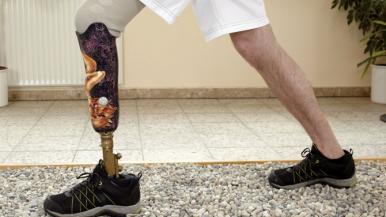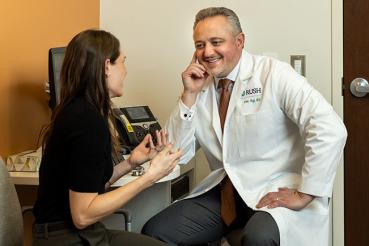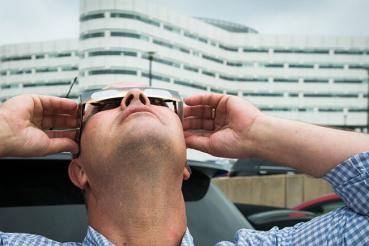In the wake of the Boston Marathon bombings in April 2013, stories emerged about survivors who lost one or both of their legs during the blasts.
The strength, courage and determination of these men and women resonated with Chirag Shah, MD.
That's because Shah, a physical medicine and rehabilitation specialist at Rush University Medical Center, often sees those same qualities in the patients he cares for at Rush's Prosthetics and Orthotics Clinic.
The team at the clinic helps people of all ages who lose their limbs to trauma or disease get their lives back — and, in many cases, literally get back on their feet.
Here, Shah discusses the challenges of losing limbs. And how research is leading to better, smarter prosthetics.
Helping people cope with losing limbs
Losing a limb is an extremely traumatic, life-changing experience. But it doesn't mean that you can't eventually get back to doing everything you did before and lead a full, active life.
Our team addresses not only the physical disability but the mental aspects of coping with limb loss. If it's an amputation that’s been scheduled, we start working to help the patient accept the limb loss even before the surgery takes place.
We also have amputees who have already gone through the process of getting their prosthetics come in and share their experiences with new amputees, as well as offer encouragement.
Overcoming adversity
Generally speaking, a younger, healthy person is going to get back on their feet much quicker than an elderly person or someone with a lot of pre-existing medical conditions.
If you weren't dealing with a chronic medical condition before the amputation, you have a much better chance of quickly recovering and progressing back to everyday activity.
But it can be more challenging psychologically and emotionally for traumatic amputees.
For many patients who suffer from peripheral vascular disease or diabetes — and often they have multiple chronic health conditions — amputation becomes a life choice: They want to remove this limb so it's not affecting the rest of their body.
In those situations, patients have more time to understand and accept the situation. They're able to achieve some semblance of closure because they and their family have decided, OK, this is the next step.
With something like combat, an accident or the Boston Marathon bombing, the patients are waking up and their limbs are missing.
Most of these were healthy individuals before the trauma, so they get to the point where their skin has healed and they can get up and start walking with prosthetics, but they need a greater focus on counseling to get them mentally prepared to live as an amputee.
So for some of our trauma patients, we will start their prosthetic fittings earlier than we would for patients who have scheduled amputations, just to get them started on that road to recovery a bit faster.
Learning to walk with a prosthetic
Healthy patients who lose their limbs during a trauma are usually back on their feet within a month of the amputation. But it's a process. It doesn't happen overnight. Most people don’t realize the amount of work it takes to retrain your body and learn to walk again.
There's a common misconception that you get fitted for your prosthetic, put it on and start walking right away. The simple activities come first, and the higher-level activities come next: running, other sports, etc.
Once patients start to conquer the small things, they gain more confidence, and as they build up their confidence, they're going to be able to do more and more.
We don't measure success by what other people have achieved. It's about each person working toward their personal goals.
Measuring progress one goal at at time
How far patients progress, and how quickly, depends a lot on what kind of condition they were in before the amputation.
For some of our patients with traumatic amputations, their ultimate goal is to have a highly active lifestyle, and we may be able to help them achieve that. But a lot of what we do is just tempering a patient's expectations. We help them realize that it's all about baby steps.
While they're still in the hospital, we start with getting out of bed, then standing, then walking to the bathroom, then walking around the unit, then walking on uneven surfaces, and then walking up and down stairs.
We don't measure success by what other people have achieved. It's about each person working toward their personal goals.
How the level of the amputation affects function
The higher on the leg the amputation, the more energy you have to expend to accomplish what you were able to with a full leg or legs. That's true even for something as basic as standing up or walking.
Most of the amputations we see are below the knee, but you'll see them coming all the way up to the hip.
Once you get above the knee, that energy expenditure is more than 100 percent greater than it is for an able-bodied person. It takes strong will and endurance and strength to walk with an above-the-knee amputation.
In fact, some people with above-the-knee amputations aren't able to walk even with prosthetics, but we'll fit them for the prosthetics simply to make it easier for them to transfer from their bed to their wheelchair.
So not all prosthetics are just for getting around. Sometimes, they're just for transfers or even cosmetic reasons: Some patients don't want to be seen as not having a leg.
The road to recovery
People may face a variety of issues as they recover and start to get back to their day to day lives. It truly varies from person to person what those issues are.
The traumatic victims may be up and moving around much more quickly with their prosthetics.
Patients with vascular disease, diabetes or stroke may have been confined to bed for months, maybe even a year before they have the amputation, so they're very deconditioned from that and will likely have a longer road to recovery.
That means family members and friends will have to help out for a longer period of time with things like grocery shopping, cleaning, paying bills and even bathing and dressing the patient.
As a whole, it's important just to have a whole network of people and organizations to help modify anything the patient needs — both initially and down the road. For instance, you're going to have a lot of doctor's and physical therapy appointments, and you'll need transportation to and from those appointments.
Help with driving
Not being able to drive is often a huge issue. People want their independence back, and the ability to drive is often crucial to feeling independent: You don't want to have to rely on family and friends drive you wherever you need to go all the time.
If a person is missing the right leg, however, they may not be comfortable driving a car with a prosthesis. What we can do is have an accelerator put on the left side, so the patient learns to drive with the left foot, or install hand controls so the person can drive with their hands instead of feet.
The evolution of prosthetics
In the past 20 years, we've gone through a real renaissance in prosthetic technology. One of the biggest advances is prosthetic feet with adjustable heel-height.
Previously, for all prosthetics, the ankles were fixed. So if the height of the prosthesis was set to accommodate a shoe and you took off your shoe or changed into a higher or lower shoe, the height of the prosthetic would be off and it would completely change the way you walked.
With the adjustable heel-height, you can go back and forth between barefoot, flat shoes and high heels; you simply adjust the prosthesis accordingly.
What's on the horizon for prosthetics
The goal is to transition into the idea of a more truly bionic leg. The hottest thing right now, technology-wise, is "smart prosthetics" with on-board microprocessors for the ankle and knee.
Traditional prosthetics are passive, meaning you have to teach patients how to walk with a certain pattern based on how the prosthetic is going to respond to each movement. But there's a lot of research going on to try to make that connection between the patient's brain and the prosthesis so the patient can control the prosthetic leg just like they used to control their own leg. That's the next big innovation.
Options for those who don't want prosthetics
It's important to get to know what the patient wants and to respect their wishes, and not every patient wants a prosthetic.
Our team at the clinic will still come up with a comprehensive plan for them. They're going to need modifications to their wheelchairs. They may still need a compression shrinker sock (a tight, elastic stocking) to reduce swelling in their stumps. And there are still things we want to do therapeutically to their legs to prevent pain and keep them comfortable.
In addition to the amputation and prosthetics clinic, we offer a wheelchair clinic in seating and positioning at Rush, for everyone from toddlers to older adults.
Rush wheelchair clinic offers full range of services
Patients can come in for a new evaluation for an appropriate mobility device. Or if they have an existing wheelchair that's not appropriate for them or is broken.
We look for skin breakdown and ensure that the patient is not in pain or feeling uncomfortable. That includes making sure the cushion is properly fitted.
We also make sure the wheelchair fits in the patient's house, because if the patient can’t use the wheelchair, there's no point in having it.
The goal for patients in wheelchairs is the same as for people with prosthetics: to help restore their lifestyles — as much as possible — to where they were pre-amputation.
In many cases, we have patients who get to the point where they’re even more active and more involved than before they lost their limb. They come to accept losing limbs as part of their identities and move on to open new chapters in their lives.




